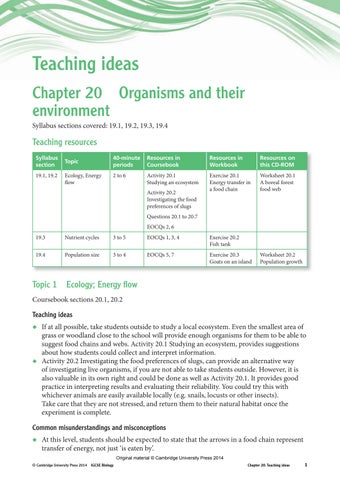Teaching ideas Chapter 20 Organisms and their environment Syllabus sections covered: 19.1, 19.2, 19.3, 19.4
Teaching resources Syllabus section 19.1, 19.2
Topic Ecology, Energy flow
40-minute periods
Resources in Coursebook
Resources in Workbook
Resources on this CD-ROM
2 to 6
Activity 20.1 Studying an ecosystem
Exercise 20.1 Energy transfer in a food chain
Worksheet 20.1 A boreal forest food web
Activity 20.2 Investigating the food preferences of slugs Questions 20.1 to 20.7 EOCQs 2, 6 19.3
Nutrient cycles
3 to 5
EOCQs 1, 3, 4
Exercise 20.2 Fish tank
19.4
Population size
3 to 4
EOCQs 5, 7
Exercise 20.3 Goats on an island
Topic 1
Ecology; Energy flow
Worksheet 20.2 Population growth
Coursebook sections 20.1, 20.2 Teaching ideas ◆
If at all possible, take students outside to study a local ecosystem. Even the smallest area of grass or woodland close to the school will provide enough organisms for them to be able to suggest food chains and webs. Activity 20.1 Studying an ecosystem, provides suggestions about how students could collect and interpret information. ◆ Activity 20.2 Investigating the food preferences of slugs, can provide an alternative way of investigating live organisms, if you are not able to take students outside. However, it is also valuable in its own right and could be done as well as Activity 20.1. It provides good practice in interpreting results and evaluating their reliability. You could try this with whichever animals are easily available locally (e.g. snails, locusts or other insects). Take care that they are not stressed, and return them to their natural habitat once the experiment is complete. Common misunderstandings and misconceptions ◆
At this level, students should be expected to state that the arrows in a food chain represent transfer of energy, not just ‘is eaten by’. Original material © Cambridge University Press 2014
© Cambridge University Press 2014 IGCSE Biology
Chapter 20: Teaching ideas
1
